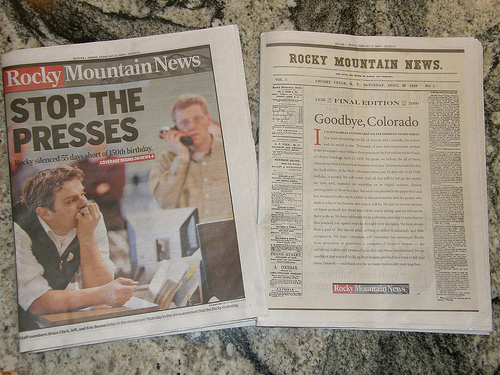A couple weeks ago, Mike Masnick pointed to an interesting post-mortem of the Rocky Mountain News by John Temple, a former RMN staffer:
We knew the web was a place we needed to be, but we didn’t have a clear strategy, mission, or objective. It was a complement to the paper, as we said in our initial “about us” page. Which brings me to lesson 3. You have to have a strategy, and you have to be committed to pursuing it. We perceived the website as a newspaper online, as a complement to the paper, not as its own thing. That’s not a strategy. Senior management’s focus in the 1990s was on keeping the newspaper alive. Again, to be clear, that’s understandable, at least to a point. We were fighting for our lives, and the money then lay in print. We didn’t understand the web or new technology, and didn’t have the time to learn much about it. We weren’t a consumer-driven company, except that we knew that our priority was to get papers on the porch on time in the morning. Otherwise, we feared our subscribers would switch to the competitor.
The thing that I found puzzling about this is that they actually did have a web strategy. In fact, they had several of them. Temple tells us that, at several points over the last two decades, the Rocky unveiled new web-based initiatives. Indeed, the Rocky launched its first online edition in 1990, with a pre-web dial-up service. The service didn’t seem to be improving the company’s bottom line, so it was shut down after a few months. This pattern was repeated in the following years: new websites would be launched, and each time management would discover that the web didn’t generate significant revenue and decide to devote the bulk of their resources to the print edition.
Temple portrays this as strategic fecklessness, but I think a more charitable explanation is more plausible: the Rocky actually was a consumer-driven company. Consumer-driven companies focus on the needs of their paying customers, and to this day, a newspaper’s paying customers are predominantly print subscribers and print advertisers. It would have been crazy for the Rocky to ignore its paying customers and bet the farm on a new technology with no obviously prospect of generating significant revenue. Experimenting with new technologies made sense, but it also made sense to scale back those experiments when they failed to pan out.
Temple seems to believe that a better web strategy could have saved the Rocky, but I don’t actually see much reason to believe that. The New York Times and the Washington Post were both early leaders in online content. They have the luxury of being national brands, and they’ve both built fantastic websites with millions of readers. Yet that hasn’t stopped either one of them from experiencing the same precipitous financial decline that has afflicted the rest of the newspaper industry. The harsh reality is that no one has figured out how to transform a daily newspaper into a profitable online business.
Temple seems to feel there was more the Rocky’s management could have done to forestall the paper’s demise. And obviously with the benefit of hindsight we can look back and point out individual tactical mistakes. But I suspect that ultimately, the Rocky was crushed by the same broad and near-irresistible economic forces that is crushing its sister publications across the country. Its management appears to have done more or less what it should have. That they didn’t find a profitable web strategy isn’t necessarily the fault of those managers; perhaps there was simply no web strategy to be found.



